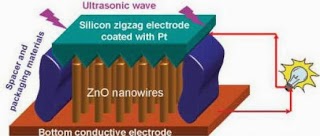12/20/13
Nanogenerators
Do you like this story?

Rechargeable batteries
Consumer electronic devices such as laptop computers and cell phones, portable systems, health monitoring, infrastructure, environmental monitoring, defense technologies and many other micro and nano systems require small power in the range of micro to milli Watts.
For operating these portable electronics devices the current technology mainly relies on rechargeable batteries. But the traditional batteries have their inherent drawbacks and may not meet or be the only choice as power sources and hence the reason for new ultra light weight, high power battery developments.
Nanogenerator
A new idea is to have self powered nanotechnology, aiming at powering these devices using the energy harvested from the environment in which the systems are supposed to operate. The answer is nanogenerator.
Nanogenerator is a technology that converts mechanical or thermal energy produced on small-scale into electricity. Nanogenerator can be broadly three types: piezoelectric, triboelectric, and pyroelectric nanogenerators. Both the piezoelectric and triboelectric nanogenerators can convert the mechanical energy into electricity. However, the pyroelectric nanogenerators attract attention as it can be used to harvest thermal energy from a time-dependent temperature fluctuation.
Pyroelectric effect
Heat can be converted to electricity using the pyroelectric effect, first described by the Greek philosopher Theophrastus in 314 B.C., when he noticed the gemstone tourmaline produced static electricity and attracted bits of straw when heated. Heating and cooling rearrange the molecular structure of certain materials, including tourmaline that creates an imbalance of electrons to generate electricity.
Pyroelectric properties of nanowires
Ferroelectric nanowires have pyroelectric effect and can be used for the production of power. The magnitude of this effect depends on a coefficient named pyroelectric coefficient corresponding to the radius of the wire and its coupling and governed by size effect. The smaller the wire radius, the more the pyroelectric coefficient diverges until a critical radius at which the response changes to paraelectric (above the Curie temperature). This effect could be used to tune the phase transition temperatures in ferroelectric nanostructures, thus enabling a system with a large, tunable, pyroelectric response.
Pyroelectric nanogenerator
Ukrainian and American researchers have developed a pyroelectric nanogenerator. The nanogenerator can be the basis for self-powered nanotechnology that harvests thermal energy from the time-dependent temperature fluctuation for applications in wireless sensors, temperature imaging, medical diagnostics and personal microelectronics.
The researchers used an array of zinc oxide nanowires of short lengths standing on end to make a device to produce electricity when heated or cooled or even due to temperature fluctuation from day to night.
Applications of pyroelectric nanogenerator
Pyroelectric energy may bring about a new era of "tiny energy" and pyroelectric nanogenerators could be extremely useful for powering specific tasks in in-vitro biological applications, medicine and nanotechnology, particularly in space because they perform well in low temperatures. They do not contain any moving parts and could be suitable for long-term operation in ambient applications and can play key role in consumer electronics.
Carbon nanotubes for thermoelectric nanogenerator
Generally thermoelectrics are an underdeveloped technology for harvesting energy, yet there is so much opportunity. But cost has prevented thermoelectrics from being used more widely in consumer products. Available thermoelectric devices use a much more efficient compound called bismuth telluride to turn heat into power in products including mobile refrigerators and CPU coolers, but their cost is very high.
Researchers in the Center for Nanotechnology and Molecular Materials at Wake Forest University developed a fabric like Power Felt. Power Felt is a thermoelectric device that converts even body heat into an electrical current.
This device consists of tiny carbon nanotubes locked up in flexible plastic fibers. The technology uses small temperature differences like room temperature versus body temperature to create a charge. Currently, 72 stacked nanotube layers in the fabric yield about 140 nanowatts of power.
Applications of Power Felt
Potential uses for Power Felt include lining automobile seats to boost battery power and service electrical needs, insulating pipes or collecting heat under roof tiles, lining clothing or sports equipment to monitor performance, or wrapping wounded sites on the body to better track patients' medical needs. It can provide relief during power outages or accidents, when wrapped around a flashlight can powering weather radio or charge a cell phone or power an iPod. The researchers claim that they can make a jacket with a completely thermoelectric inside liner that gathers warmth from body heat, while the exterior remains cold from the outside temperature to make an effective Power Felt. They are evaluating several ways to add more and make them even thinner to boost the power output.
Subscribe to:
Post Comments (Atom)









0 Responses to “Nanogenerators ”
Post a Comment